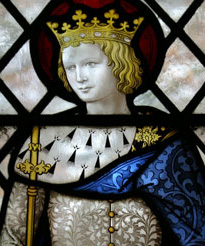Saint of the Day Online - St Edward the Confessor
Saint of the day online, Friday, October 13, 2017
12-10-2017
Saint Name: Edward the Confessor
Place: England
Birth: 1003
Death: 5 January 1066
Feast: October 13
Edward the Confessor who was born on 1003 is also known as Saint Edward the Confessor, was among the last Anglo-Saxon kings of England. Usually considered the last king of the House of Wessex, he ruled from 1042 to 1066.
He was born at Islip, England, and sent to Normandy with his mother in the year 1013 when the Danes under Sweyn and his son Canute invaded England. Canute remained in England and the year after Ethelred's death in 1016, married Emma, who had returned to England, and became King of England. Edward remained in Normandy, was brought up a Norman, and in 1042, on the death of his half-brother, Hardicanute, son of Canute and Emma, and largely through the support of the powerful Earl Godwin, he was acclaimed king of England.
Edward spent a quarter of a century in exile, probably mainly in Normandy, although there is no evidence of his location until the early 1030s. He probably received support from his sister Godgifu, who married Drogo of Mantes, count of Vexin in about 1024. In the early 1030s Edward witnessed four charters in Normandy, signing two of them as king of England. According to the Norman chronicler, William of Jumièges, Robert I, Duke of Normandy attempted an invasion of England to place Edward on the throne in about 1034, but it was blown off course to Jersey. He also received support for his claim to the throne from a number of continental abbots, particularly Robert, abbot of the Norman abbey of Jumièges, who was later to become Edward's Archbishop of Canterbury. Edward was said to have developed an intense personal piety during this period, but modern historians regard this as a product of the later medieval campaign for his canonisation. In Frank Barlow's view "in his lifestyle would seem to have been that of a typical member of the rustic nobility". He appeared to have a slim prospect of acceding to the English throne during this period, and his ambitious mother was more interested in supporting Harthacnut, her son by Cnut.
Cnut died in 1035, and Harthacnut succeeded him as king of Denmark. It is unclear whether he was intended to have England as well, but he was too much occupied in defending his position in Denmark to come to England to make good any claim. It was therefore decided that his elder half-brother Harold Harefoot should act as regent, while Emma held Wessex on Harthacnut's behalf. In 1036 Edward and his brother Alfred separately came to England. Emma later claimed that they came in response to a letter forged by Harold inviting them to visit her, but historians believe that she probably did invite them in an effort to counter Harold's growing popularity. Alfred was captured by Godwin, Earl of Wessex who turned him over to Harold Harefoot. He had Alfred blinded by forcing red-hot pokers into his eyes to make him unsuitable for kingship, and Alfred died soon after as a result of his wounds. The murder is thought to be the source of much of Edward's later hatred for the Earl and one of the primary reasons for Godwin's banishment in autumn 1051. Edward is said to have fought a successful skirmish near Southampton, and then retreated back to Normandy. He thus showed his prudence, but he had some reputation as a soldier in Normandy and Scandinavia.
In 1037 Harold was accepted as king, and the following year he expelled Emma, who retreated to Bruges. She then summoned Edward and demanded his help for Harthacnut, but he refused as he had no resources to launch an invasion, and disclaimed any interest for himself in the throne. Harthacnut, his position in Denmark now secure, did plan an invasion, but Harold died in 1040, and Harthacnut was able to cross unopposed with his mother to take the English throne.
In 1041 Harthacnut invited Edward back to England, probably as heir because he knew he had not long to live. The 12th century Quadripartitus, in an account regarded as convincing by historian John Maddicott, states that he was recalled by the intervention of Bishop Ælfwine of Winchester and Earl Godwin. Edward met "the thegns of all England" at Hursteshever, probably modern Hurst Spit opposite the Isle of Wight. There he was received as king in return for his oath that he would continue the laws of Cnut.According to the Anglo-Saxon Chronicle Edward was sworn in as king alongside Harthacnut, but a diploma issued by Harthacnut in 1042 describes him as the king's brother.
Edward's difficulties continued after Godwin's death in 1053 with Godwin's two sons: Harold who had his eye on the throne since Edward was childless, and Tostig, Earl of Northumbria. Tostig was driven from Northumbria by a revolt in 1065 and banished to Europe by Edward, who named Harold his successor. After this Edward became more interested in religious affairs and built St. Peter's Abbey at Westminster, the site of the present Abbey, where he is buried. His piety gained him the surname "the Confessor". He died in London on January 5, and he was canonized in 1161 by Pope Alexander III.
His feast day is October 13.